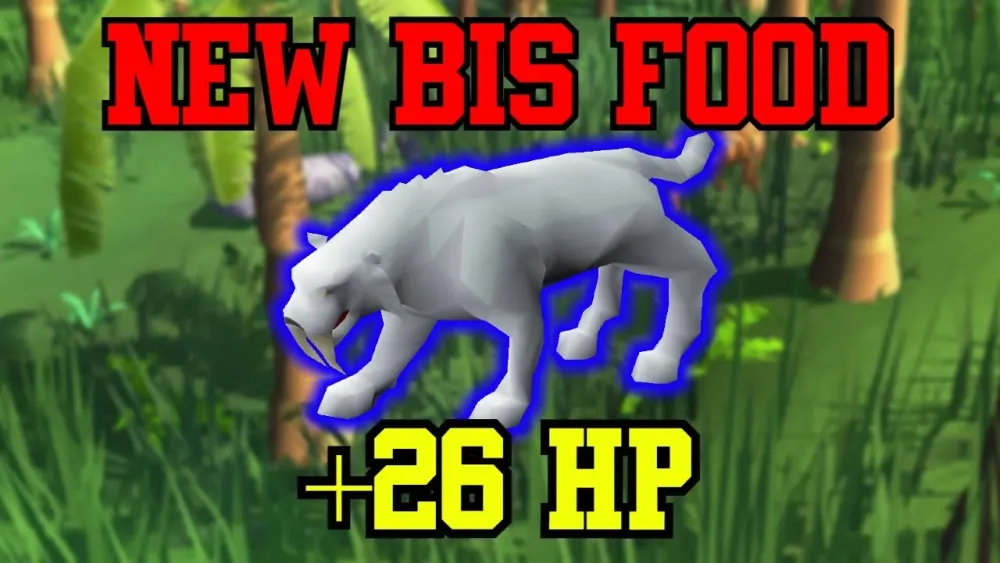Your cart is empty
OSRS Best Food to Use for Healing and Combat

In Old School RuneScape (OSRS), food is your lifeline, whether you’re battling bosses, grinding Slayer tasks, or surviving in the Wilderness. Choosing the right food can make the difference between victory and a swift trip back to Lumbridge. This guide explores the best foods in OSRS for both free-to-play (F2P) and pay-to-play (P2P) players, focusing on healing efficiency, cost, and gameplay mechanics like combo eating. From budget-friendly options to high-end healing items, we’ve got you covered for every playstyle.
Before diving into the best foods, it’s crucial to understand how food works in OSRS. Most foods restore hitpoints (HP), but some offer additional effects like stat boosts or overhealing. Food can be obtained through Cooking, Farming, monster drops, or the Grand Exchange. The game operates on a tick system (0.6 seconds per tick), and most foods have a 3-tick (1.8-second) delay before you can attack or eat again. However, “fast foods” like Karambwans have shorter delays, making them ideal for combo eating.
What is Combo Eating?
Combo eating involves consuming a standard 3-tick food (e.g., Shark) followed immediately by a fast food (e.g., Karambwan) to heal a large amount of HP in a short time. For example, a Shark (20 HP) + Karambwan (18 HP) combo can heal 38 HP in about 1.2 seconds, crucial for high-stakes PvM or PvP scenarios.
Factors to Consider When Choosing Food
- Healing Amount: Higher HP restoration is better for tough fights.
- Cost Efficiency: Budget foods are ideal for grinding or mid-level players.
- Eat Delay: Fast foods reduce downtime in combat.
- Inventory Space: Stackable or multi-bite foods save slots.
- Availability: Some foods require high skill levels or quests.
Best F2P Foods in OSRS
Free-to-play players have fewer options, but there are still solid choices for healing during combat or training. These foods are accessible, affordable, and effective for early-game content.
Swordfish
Swordfish is the top F2P food, healing 14 HP per bite. It’s perfect for prolonged fights and widely available on the Grand Exchange for around 300–400 GP each. You can catch and cook them with 45 Fishing and 50 Cooking, making them a reliable choice for F2P players.
Pros: High healing, easy to obtain.
Cons: Slower to gather than lower-tier fish.
Anchovy Pizza
Anchovy Pizza heals 18 HP over two bites (9 HP each), making it the highest-healing F2P food. It’s great for inventory efficiency and costs about 600 GP on the Grand Exchange. You can make it with 55 Cooking or loot it from Wilderness bosses like Scorpia or Chaos Elemental.
Pros: High total healing, decent for combos.
Cons: Two bites slow healing in emergencies.
Tuna
Tuna is a budget-friendly option, healing 10 HP for about 100 GP each. It’s ideal for early-game players with 35 Fishing and 30 Cooking. While it’s less effective for tougher content, it’s cheap and easy to stockpile.
Pros: Inexpensive, widely available.
Cons: Low healing limits its use in high-damage fights.
Best P2P Foods for Everyday Use
Pay-to-play players have access to a wider variety of foods, from cost-effective options for Slayer to high-healing items for bossing. These foods balance healing, cost, and ease of access.
Monkfish
Monkfish heal 16 HP and cost around 300 GP each. They’re a staple for mid-level players, requiring 62 Fishing and 62 Cooking. They stop burning at level 90 on a range, making them easier to cook than Sharks.
Pros: Balanced cost and healing, reliable for Slayer.
Cons: Outclassed by higher-tier foods in endgame content.
Sharks
Sharks heal 20 HP and are a classic choice for combat, costing about 900 GP each. They require 76 Fishing and 80 Cooking, but they’re widely available on the Grand Exchange. Sharks are versatile for Slayer, dungeons, and mid-tier bossing.
Pros: High healing, easy to buy in bulk.
Cons: Expensive for their healing output compared to alternatives.
Summer Pie
Summer Pies heal 22 HP over two bites (11 HP each), boost Agility by 5, and restore 10% run energy. They cost around 700 GP and require 95 Cooking. Their fast eat time (0.6 seconds per bite) makes them ideal for multi-bite healing in PvM.
Pros: High healing, additional buffs, affordable.
Cons: Two bites can slow emergency healing.
Top-Tier P2P Foods for Endgame Content
For high-level bossing, raids, or PvP, you need foods that maximize healing, support combo eating, or offer unique effects like overhealing. These are the best options for advanced players.
Tuna Potato
Tuna Potatoes heal 22 HP in one bite, tying with Dark Crabs and Manta Rays as the highest-healing single-bite foods. They cost around 1,200 GP and require 68 Cooking. Their cost efficiency makes them a go-to for Slayer and mid-tier bossing.
Pros: High healing, cost-effective.
Cons: Complex to make, requiring multiple ingredients.
Anglerfish
Anglerfish are the ultimate emergency food, healing up to 22 HP (scaling with HP level) and allowing overhealing above your maximum HP. They cost about 1,500 GP and require 82 Fishing and 84 Cooking. They’re perfect for raids or bossing where extra HP can save your life.
Pros: Overhealing, high healing at high HP levels.
Cons: Expensive, requires high skills.
Cooked Karambwan
Cooked Karambwans heal 18 HP and are the best fast food, with a 1-tick delay for combo eating. They cost around 500 GP and require 65 Fishing and 30 Cooking. They’re essential for PvP, Inferno, or Theatre of Blood due to their speed.
Pros: Fast eating, combo-friendly.
Cons: Slightly lower healing than other top-tier foods.
Specialty Foods and Combo Eating Strategies
Advanced players often use specialty foods or potions to optimize healing in specific scenarios. These options are niche but powerful when used correctly.
Saradomin Brew
Saradomin Brews are potions, not food, but they’re critical for combo eating in endgame content. They heal 15% of your HP per dose (up to 64 HP total for four doses) and boost Defence, costing around 3,000 GP per potion. A common combo is Shark + Karambwan + Brew dose, healing up to 54 HP in 1.2 seconds.
Pros: Massive healing in combos, stackable.
Cons: Lowers offensive stats, expensive.
Purple Sweets
Purple Sweets are stackable, healing 1–3 HP and restoring 10% run energy per sweet. They cost around 10,000 GP each and are obtained from clue scrolls. They’re ideal for skilling or low-damage Slayer tasks where inventory space is key.
Pros: Stackable, infinite healing potential.
Cons: Low healing per sweet, very expensive.
Table of Best Foods in OSRS
| Food | Healing (HP) | Cost (GP) | F2P/P2P | Special Features |
|---|---|---|---|---|
| Swordfish | 14 | 300–400 | F2P | High F2P healing |
| Anchovy Pizza | 18 (9×2) | 600 | F2P | Two bites, combo-friendly |
| Monkfish | 16 | 300 | P2P | Cost-effective |
| Sharks | 20 | 900 | P2P | Versatile, high healing |
| Tuna Potato | 22 | 1,200 | P2P | Highest single-bite healing |
| Anglerfish | Up to 22 | 1,500 | P2P | Overhealing |
| Cooked Karambwan | 18 | 500 | P2P | Fast eating, combo-friendly |
Key Takeaways for Choosing OSRS Food
- F2P Players: Stick to Swordfish or Anchovy Pizza for cost-effective, high healing.
- Mid-Level P2P: Monkfish and Sharks are great for Slayer and dungeons.
- Endgame P2P: Use Tuna Potatoes, Anglerfish, and Karambwans for bossing and PvP.
- Combo Eating: Pair Karambwans with Sharks or Brews for massive healing bursts.
- Budget Grinding: Summer Pies and Monkfish offer great value for prolonged tasks.
By selecting the right food for your activity, budget, and playstyle, you’ll maximize your survival and efficiency in OSRS. Whether you’re a newbie fishing for Tuna or a veteran stocking up on Anglerfish, this guide has you covered. Happy adventuring in Gielinor!
